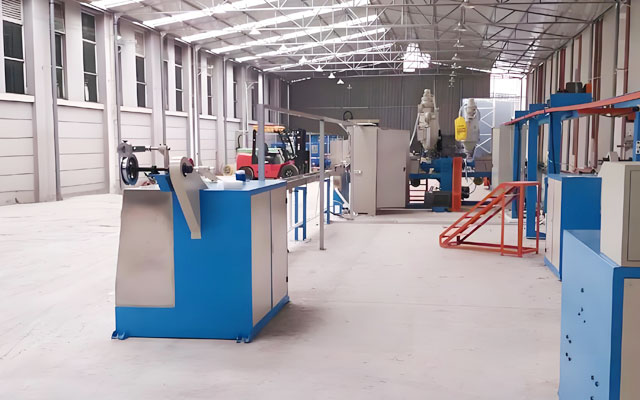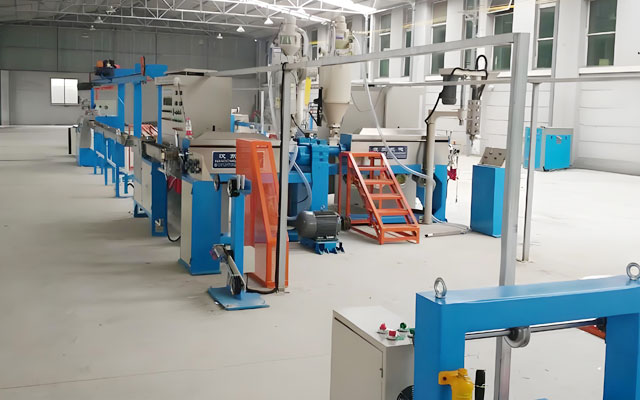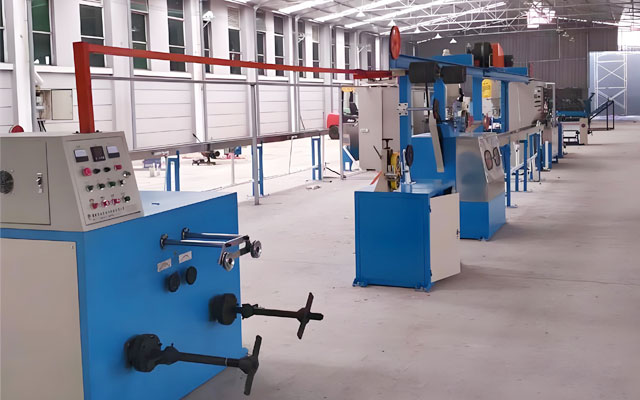Model 30-90Screw Diameter φ30-90 mmL/D Ratio 26:1/25:1Extrusion Output 25-250 kg/hrMain Motor 18-63 KWOutlet Diameter 0.2-35 mmSpeed 10-600 m/minApplication Electronic wire
Electronic Wire Extrusion Line
The electronic wire extrusion production line is the most core and critical process in wire and cable manufacturing. Its essence is to use an extruder to melt plastics (such as PVC, PE, Teflon, etc.) and uniformly coat them onto the surface of metal conductors (such as copper wires), forming a uniform, continuous, and smooth insulating layer or sheathing layer.
Electronic Wire Extrusion Line Display


Main Components:
Pay-off Equipment:Function: To place and release the conductor (copper wire, stranded wire, etc.). It requires stable pay-off with controllable and uniform tension to avoid thinning or damaging the conductor.
Types: Passive pay-off (pulled by traction force) and active pay-off (actively controlling pay-off speed and tension).
Extruder:Function: To heat and plasticize solid plastic pellets into a molten state and, through screw rotation, generate pressure to continuously and steadily deliver the molten plastic to the die head.
Components:
Screw: The core component. Its design (aspect ratio, compression ratio) varies based on material characteristics (e.g., PVC, PE, Teflon), determining plasticization效果 and output.
Barrel: Encases the screw, equipped with external heaters and cooling fans for precise control of processing temperature.
Drive System: Provides stable rotational speed for the screw via a motor and gearbox.
Die Head and Mold:Function: To receive the molten plastic from the extruder and shape it into the desired coating layer through specific mold configurations.
Mold Types:
Pressure-type Mold: The molten plastic is extruded through the mold and coated onto the conductor. Primarily used for insulation extrusion, ensuring tight coating.
Tubing-type Mold: The molten plastic forms a tube within the mold and wraps around the conductor at the mold exit. Mainly used for sheathing extrusion, providing a smooth surface and low internal stress.
Cooling Trough:Function: To rapidly cool and set the high-temperature wire after it passes through the mold, now coated with an insulating layer. Insufficient cooling can lead to deformation and reduced insulation performance.
Methods: Segmented cooling (hot water cooling followed by cold water cooling) and vacuum cooling (to prevent internal air pockets).
Capstan (Puller):Function: To provide stable and constant pulling force, drawing the wire through the entire production line. The stability of the pulling speed directly determines the consistency of the wire's outer diameter.
Types: Caterpillar capstan and wheel-type capstan.
Take-up Equipment:Function: To wind the finished wire neatly and tightly onto a reel.
Requirements: Take-up tension must match the pulling speed, and automatic reel changing should be possible to ensure continuous production.
Auxiliary Equipment:Spark Tester: Online detection of insulation layer defects such as pinholes or scratches, which is critical for ensuring product quality.
Diameter Gauge: A laser micrometer for online real-time monitoring of the wire's outer diameter, providing feedback to fine-tune pulling speed or extrusion volume.
Printing Device: Online printing or embossing of identifiers (e.g., specifications, standards, manufacturer name) onto the insulation layer.
Tension Control System: Coordinates and controls the tension between pay-off, pulling, and take-up to ensure smooth operation.
Classification
Extrusion production lines can be classified in various ways:
1. By Number of ExtrudersSingle Extruder Production Line: The most common type, capable of extruding only one layer of material, such as a single insulation layer or sheathing layer. Used for standard electronic wires (e.g., UL1007).
Co-extrusion Production Line: Two or more extruders share one die head to simultaneously extrude two different materials.
Application: Used for manufacturing double-layer insulated wires, shielded wires (inner insulation layer + outer sheathing layer), and halogen-free low-smoke flame-retardant wires (inner base material + outer flame-retardant material).
2. By Coating ObjectInsulation Extrusion Line: Applies an insulating layer onto the conductor.
Sheathing Extrusion Line: Applies an outer protective sheath onto the core wire (which may already consist of multiple insulated strands or have a shielding layer).
3. By Material Process CharacteristicsPVC/PE Extrusion Line:Characteristics: The most common type, with relatively low processing temperatures (150-200°C) and mature technology. The screw aspect ratio is typically 20:1 to 25:1. Requires an efficient cooling system.
Silicone Rubber Extrusion Line:Characteristics: Silicone rubber is prone to adhesion, often requiring a hot-feed extruder (with strip feeding equipment), a short screw, and a low compression ratio. The production line is equipped with a high-temperature vulcanization tube (replacing the water trough) to cure the silicone rubber.
Teflon (FEP/PTFE) Extrusion Line:Characteristics: Extremely high processing temperatures (350-400°C) demand high corrosion resistance for the extruder barrel and screw (requiring special alloys like Inconel). The production line must be highly precise and equipped with special sintering ovens (for PTFE) and cooling systems.
Irradiation Cross-linking Line:Characteristics: This is not a standalone extrusion line but rather an additional step after standard extrusion (typically using polyolefin materials), involving an electron irradiation accelerator. The wire is exposed to a high-energy electron beam, changing its molecular structure from linear to network, thereby achieving excellent heat resistance, wear resistance, and flame retardancy. This is a key process for manufacturing high-end electronic wires.
Electronic Wire Extrusion Line Datasheet
| Model |
30 |
40 |
50 |
60 |
70 |
80 |
90 |
| Screw Diameter (mm) |
φ30 |
φ40 |
φ50 |
φ60 |
φ70 |
φ80 |
φ90 |
| Screw L/D Ratio |
25:1 |
25:1 |
26:1 |
26:1 |
26:1 |
26:1 |
26:1 |
| Extrusion Amount (kg/hr) |
25 |
40 |
70 |
100 |
140 |
200 |
250 |
| Outlet Wire (mm) |
0.2-1 |
0.4-3 |
0.8-5 |
1-8 |
2-15 |
3-25 |
5-35 |
| Total Power (KW) |
18 |
20 |
25 |
33 |
40 |
55 |
63 |
| Traction Power (KW) |
2.2 |
2.2 |
4 |
4 |
4 |
5.5 |
5.5 |
| Production Speed (m/min (Max.)) |
600 |
600 |
600 |
500 |
500 |
300 |
300 |
| Take-up Spool (mm) |
φ200-400 |
φ300-500 |
φ400-630 |
φ400-630 |
φ500-630 |
φ800-1000 |
φ1000-1250 |
Electronic Wire Extrusion Line Application
Different types of electronic wire extrusion production lines are used to manufacture various kinds of electronic wires to meet the demands of downstream industries. The specifics are as follows:
Production Line Type Typical Products Manufactured Application Areas
Standard PVC/PE LineTypical products: UL1007, UL1061, AVR, H05V-K, etc.
Application: Internal wiring of household appliances, general electronic connecting wires, low-voltage power wires.
Co-extrusion LineTypical products: Double-layer insulated wires, shielded wires with sheathing
Application: Computer internal cables, industrial control cables, audio cables; improves durability and anti-interference.
Silicone Rubber LineTypical products: UL3122, silicone rubber high-temperature wires
Application: Wiring for high-temperature applications such as electric irons, heaters, lighting fixtures, and medical device leads.
Teflon (FEP/PTFE) LineTypical products: UL1330, UL1332, UL1331
Application: Aerospace, military equipment, high-frequency data transmission cables, instrumentation in corrosive environments.
Irradiation Cross-linking LineTypical products: UL10368, UL3173, 125°C~150°C automotive wires
Application: New energy vehicle wiring harnesses, high-end home appliances (e.g., AC compressors), robotic joint cables.
High-Speed Precision LineTypical products: Ultra-fine electronic wires (34AWG~40AWG)
Application: Earphone cables, miniature connecting wires inside consumer electronics like mobile phones.




